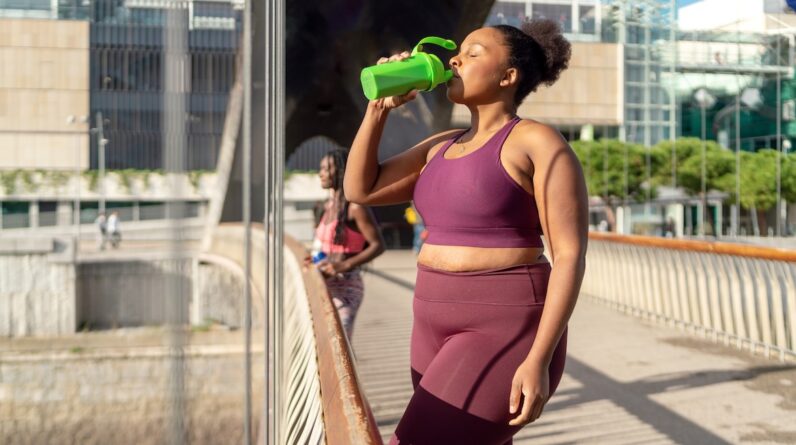
As a person who kinda sucks at immediately getting that post-workout protein, I need answers. I no sooner rack my weights and my kids are needing attention, I’ve got to shower, and maybe get dressed (emphasis on maybe). If I’m not simultaneously chugging protein, was my workout for naught?
Experts In This Article
- Roxana Ehsani, MS, RD, CSSD, LDN, Miami-based registered dietitian nutritionist
- Umo Callins, MS, RD/LD, CSSD, CPT, sports dietitian and personal trainer with with 180Physique Nutrition and Fitness
Fortunately, it seems the anabolic window is less narrow than popularly believed. Here’s what you need to know about protein timing for muscle gain.
What is the anabolic window?
You’ve likely heard that you should eat protein within 30 to 60 minutes after your weightlifting session. It’s not uncommon to see bodybuilders bring their food to the gym so that they can get in that protein during their anabolic window. But is that necessary?
“The ‘anabolic window’ is a theory that consumption of protein shortly after exercise can be helpful in muscle protein synthesis, and that this window of time is advantageous because muscle is more sensitive to protein intake at this time,” explains Umo Callins, MS, RD/LD, CSSD, CPT, sports dietitian and personal trainer with with 180Physique Nutrition and Fitness.
The anabolic window theory perpetuates the idea that you’ve got an hour or less to eat your protein.
Sounds pretty science-y doesn’t it? Let’s break it down by first explaining what “anabolic” means. It’s the body’s process of creating complex molecules from simple ones, which leads to the growth of targeted tissues.
Simply put, anabolic means building up. Anabolic processes include bones growing and strengthening or new skin tissue growing over a wound. But it’s most often referred to when speaking of muscle growth, or muscle protein synthesis. And food plays a role—more specifically, protein.
“The most important nutrient needed for muscle growth is protein. During training there’s damage that naturally happens to muscle fibers,” says Callins.
Your body turns amino acids (from dietary protein) into muscle proteins to repair or build up the affected muscle. Over time, muscle growth, or hypertrophy occurs. There are a lot of myths about protein out there, but it’s absolutely true that it’s important for building muscle.
But the anabolic window theory perpetuates the idea that you’ve got an hour or less to eat your protein. Or what? Does your body have an internal protein timer that shuts down muscle growth at the 60-minute mark?
After a deep dive into the research, it doesn’t look like that’s the case.
Is the anabolic window real?
Not quite. The anabolic window theory is based on studies1 showing increases in muscle protein synthesis after the consumption of amino acids. However, the researchers2 used long cardio workouts—which increase protein synthesis for energy rather than muscle growth.
We know that pre- and post-workout nutrition is important. Research shows3 there is better muscle growth in those who consume protein and carbs before and after a workout than those who skip the fuel altogether. But is time of the essence?
The theory makes sense, but according to Callins, there isn’t enough strong evidence to support a critical 30- to 60-minute window.
The theory makes sense, but there isn’t enough strong evidence to support a critical 30- to 60-minute window.
“More research4 has shown that this [urgency] isn’t true,” she says. “Rather, total daily protein split over multiple meals throughout the day, as well as protein quality and timing of all meals, is more important. Consuming a meal with protein within two hours of a completed workout is effective5 in building muscle.”
Two hours seems a lot more doable than an hour or less. Roxana Ehsani, MS, RD, CSSD, LDN, board-certified sports dietitian, echoes this message for those who get distracted in the minutes following a workout.
“If you miss it [the hour mark], it doesn’t mean all hope is lost. You can still reap the benefits of consuming carbs and protein post-workout, they still will aid in muscle repair and synthesis,” Ehsani says. “For the average person, it likely will not impact them if they wait a few hours to have a solid piece of protein.”
It only becomes an issue if you are a competitive athlete participating in advanced conditioning. “When you wait a few hours, you are delaying quick recovery, which is important if you are engaging in multiple workouts a day or train at a high level every day,” says Ehsani (ie., collegiate, elite, and pro athletes).
What should you eat to fuel muscle growth?
But just because there isn’t a super tight timeframe to ingest food after a workout doesn’t mean you should neglect nutrition. So what are you supposed to eat? Is the best option really isolated forms of protein, like meat or low-carb protein powder?
Thankfully, you can eat something enjoyable. While protein is essential6, that’s not the only nutrient that improves fitness. Callins says that a combination of foods is the best route.
“Protein intake helps with the repair process. However, for muscle growth to happen, enough calories (caloric surplus) have to come not only from protein but also from carbohydrates and fat,” she say. These factors paired with strength training contribute to hypertrophy.”
A balanced diet is critical for recovery7 and growing your muscles, but it doesn’t have to be all at once. Ehsani suggests spacing out your protein throughout the day. “Don’t backlog your protein to just dinner time. Try to have even portions of protein at each meal and/or snack.” The International Society of Sports Nutrition recommends5 20 to 40 grams of protein (0.25-0.40 g/kg body weight) every three to four hours.
Ehsani suggests these high-quality protein sources: “chicken breast, fish like salmon or tuna, turkey breast, eggs, Greek yogurt, nuts and seeds.”
Are you a nighttime snacker? That may work in your favor. It’s been found that eating whey or casein protein before bed8 may further increase muscle protein synthesis and promote recovery. Enjoy a glass of milk or bowl of yogurt to enhance your muscle growth.
Bottom line
So is the anabolic window real? Not really. But fueling your body with protein is beneficial, especially if you can get it in the first two hours after a workout.
“Not prioritizing balanced nutrition after your workout can lead to delayed recovery, impede performance at the next training session, and increase risk of injury,” Callins says.
Well+Good articles reference scientific, reliable, recent, robust studies to back up the information we share. You can trust us along your wellness journey.
- Schoenfeld BJ, Aragon AA. Is There a Postworkout Anabolic Window of Opportunity for Nutrient Consumption? Clearing up Controversies. J Orthop Sports Phys Ther. 2018;48(12):911-914. doi:10.2519/jospt.2018.0615
- Levenhagen DK, Gresham JD, Carlson MG, Maron DJ, Borel MJ, Flakoll PJ. Postexercise nutrient intake timing in humans is critical to recovery of leg glucose and protein homeostasis. Am J Physiol Endocrinol Metab. 2001;280(6):E982-E993. doi:10.1152/ajpendo.2001.280.6.E982
- Pihoker AA, Peterjohn AM, Trexler ET, et al. The effects of nutrient timing on training adaptations in resistance-trained females. J Sci Med Sport. 2019;22(4):472-477. doi:10.1016/j.jsams.2018.09.236
- Arent SM, Cintineo HP, McFadden BA, Chandler AJ, Arent MA. Nutrient Timing: A Garage Door of Opportunity?. Nutrients. 2020;12(7):1948. Published 2020 Jun 30. doi:10.3390/nu12071948
- Kerksick, Chad M et al. “International society of sports nutrition position stand: nutrient timing.” Journal of the International Society of Sports Nutrition vol. 14 33. 29 Aug. 2017, doi:10.1186/s12970-017-0189-4
- Deane CS, Ely IA, Wilkinson DJ, Smith K, Phillips BE, Atherton PJ. Dietary protein, exercise, ageing and physical inactivity: interactive influences on skeletal muscle proteostasis. Proc Nutr Soc. 2021;80(2):106-117. doi:10.1017/S0029665120007879
- Rustad PI, Sailer M, Cumming KT, et al. Intake of Protein Plus Carbohydrate during the First Two Hours after Exhaustive Cycling Improves Performance the following Day. PLoS One. 2016;11(4):e0153229. Published 2016 Apr 14. doi:10.1371/journal.pone.0153229
- Trommelen J, van Lieshout GAA, Pabla P, et al. Pre-sleep Protein Ingestion Increases Mitochondrial Protein Synthesis Rates During Overnight Recovery from Endurance Exercise: A Randomized Controlled Trial. Sports Med. 2023;53(7):1445-1455. doi:10.1007/s40279-023-01822-3







